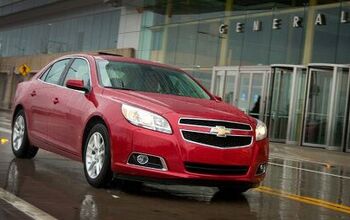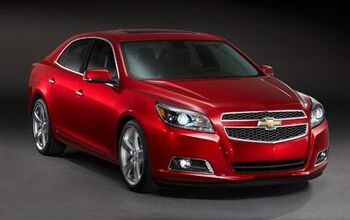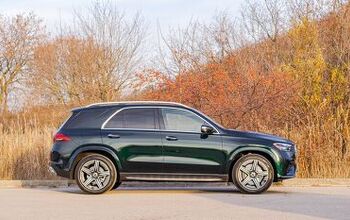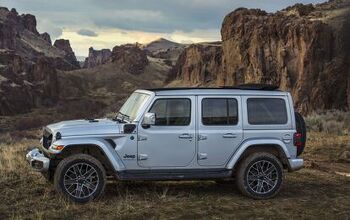2013 Chevrolet Malibu Eco Review

If the all-new Chevy Malibu were to be described in just one word, it would be “quiet.” At the vehicle’s launch event in Austin, TX, company representatives explained exactly why. First they added plenty of sound deadening materials, including a laminated front windscreen and front side windows, then they worked at absorbing solutions. The result is “the quietest Chevy ever” engineers on hand informed us, and out on the road it shows.
FAST FACTS
| 1. At launch only the Eco model will be offered with an eAssist hybrid system that adds 15 extra horsepower to the 2.4L 4-cylinder, which makes 182 hp and 172 lb-ft of torque. |
| 2. Fuel economy is rated at 25/37 mpg city/highway with a 29 mpg average. |
| 3. In 2012 Chevy will also offer a base 2.5L 4-cylidner and a turbocharged 2.0-liter. |
| 4. With a reduction in the drag coefficient from .35 to .30 over the previous Malibu, Chevy says this amounts to as much as a 2.5 mpg improvement in highway driving. |
| 5. Eco models will start from $25,995 including a $760 destination fee. |
Exterior road noise is all but eliminated and perhaps the best example we came across was when we found ourselves next to a diesel pickup truck, which was pulling a load, heading up a steep hill. After riding along in near-silence it was surprising to actually detect an outside noise. Lowering the window for a second revealed an almost unholy racket. Closing it again shut out the outside world almost completely.
In almost all other ways the new Malibu has been improved, though we’d be hard pressed to call it segment-leading.
FEELS SUBSTANTIAL, FOR BETTER AND FOR WORSE
Matching the premium-level quietness of the cabin is a comfortable ride and one that feels substantial on the road. Contributing to this is a notably wider body and track, gaining two inches in thickness. It feels less like a mid-size and more like a full size machine, an advantage on the highway but a drawback around town. A contributing factor is the raised hood (a requirement of global pedestrian safety requirements), which gives the perception that there’s a great deal of car out in front.
By comparison, a Camry and Sonata (both hybrids we should add) that Chevy brought out as a competitive test set felt well-sized and nimble in a brief test drive around downtown. The likely culprit here is that the Malibu has a slightly shorter wheelbase, while being roughly two inches longer overall.
On windier roads the Malibu hardly excites and ‘confident’ isn’t a word we’d use to describe it mid-corner. Does handling in a mid-size sedan really matter though?
It feels heftier than its 3,620 lb curb weight would suggest, that being the listed poundage for our hybrid Eco model test car – the only model available at launch. That number surprised us as, traditionally, it’s a completely acceptable weight for a car of this class, even one without a bunch of heavy hybrid components to lug around. Of note, however, many other automakers have made considerably strides to cut weight from their mid-size sedans, with the Sonata and Camry hybrids tipping the scales at 3,578 and 3,441 respectively.
CAMARO CUES INSIDE AND OUT
Adding to the car’s perception of size from the driver’s seat is a narrow rear windscreen and special mirrors that Chevy will tell you help considerably in achieving a low 0.30 coefficient of drag, but which also taper off into a point, thereby limiting your view. It’s obvious from these gripes that Chevy did more than just borrow the Camaro’s taillights when designing this car.
Outside it’s handsome enough, but no more minimalist a styling update than the new Toyota Camry. There’s a notable bangle-butt rear end and lots of sheetmetal behind the rear doors, making it look substantial when parked. That trunk design, when paired with sloping rear roof, does give the car a Volt-like appearance and we’d argue the Malibu’s best side is its backside.
Inside there are notable Camaro elements borrowed as well, from the square gauges to some silvery gloss plastic around the center stack, which we’re at least glad is used much more sparingly here than in the Camaro. Much of the buttons and controls are standard fare, from the all-too familiar stereo buttons and stalks to the Cruze-esque steering wheel – something we quite like. It’s one of the few efforts made to shrink the car’s feeling of size.
Perhaps the car’s target demographic will disagree, but we were horrified by the faux wood trim on the center stack and doors. The chrome trim was equally old-manish. At night, the Malibu’s interior is transformed, however, with plenty of ambient lighting giving a polish glow to the cabin and controls.
The standard cloth seats are actually quite pleasing to the eye, though the optional leather is a reminder that GM still buys its cows from the Fisher Price farm.
CHEVROLET MYLINK: SIMPLE AND EASY-TO-USE
Interior highlights include a new display screen between the speedometer and tachometer with trip information and other car details. It does plenty to improve the “perceived value” of the car. In addition, there’s the new easy-to-use Chevrolet MyLink system, which comes standard on the Malibu Eco.
An incredibly easy to use touch-screen (which flips up to reveal a cubby to store your cell phone), takes a familiar route to in-car telematics, moving away from a subscription service to one that is tethered to your smartphone. As a result, you don’t have to pay a monthly fee, other than what you use on your cell phone. If you listen to music on your phone it doesn’t cost a penny, and if you stream music from services like Pandora it uses your phone’s data plan. That might sound like it can get expensive, but a company rep informed us that its designed so users who don’t normally go over their monthly plan likely won’t get pushed over as a result of streaming music.
Along with some more advanced features that only the one percent of techies will ever use, MyLink also downloads your phone’s contacts list so you can use voice command to call anyone on your list.
NOT A HYBRID, OR IS IT?
While Chevrolet will eventually offer a 2.5-liter 4-cylinder version later in 2012, as well as turbocharged 2.0-liter as a V6 alternative, the current offering is limited only to the hybrid – although GM doesn’t want to use that name.
The “H” word doesn’t appear anywhere on the car and that’s because of a GM marketing strategy that wants to sell the Malibu on its merits as a car, not as a hybrid. It also helps avoid lumping it into a niche – a segment that, it just so happens, the Malibu lags behind in fuel economy. Instead, GM calls it an Eco model, using the brand’s eAssist electric motor and lithium ion battery pack mated to a 182-hp 2.4-liter 4-cylinder with direct injection.
The battery is juiced up through regenerative braking, enabling a total of 15 extra horsepower to help give the car an extra nudge. This allowed Chevy engineers to adjust the car’s final drive ratio to a 2.64, which would otherwise hamper acceleration to a sever degree, but that problem is then solved with just a mild electric assist.
Other advantages are found in the use of a start-stop system, as well as by offsetting the energy needed by the accessories, by only charging them when it’s efficient to do so.
The result is fuel economy of 25 mpg city and 37 mpg highway and an average of 29 mpg. Solid numbers for a mid-size sedan, yes, though vastly inferior to the Camry-Hybrid’s combined 41-mpg rating. In our test we saw 19 mpg city and 26 in mixed driving.
As for acceleration, GM claims a respectable 8.7 second 0-60 time and we’d argue that more power isn’t needed, even if it doesn’t feel quite as spritely as the Sonata or Camry.
As for the rest of the vehicle, the rear seats are large enough for full size adults, even if they don’t look that large – due to the use of longer seat cushions. Trunk space is 14.3 cu-ft, which is an ok amount, until you realize the Cruze delivers 15.4 cu-ft.
As a family sedan, GM is putting a lot of focus on safety with the new Malibu, which has already received a 5 Star Euro NCAP rating and is expected to earn top marks in the U.S. A total of eight airbags are standard, with two more optional and GM will eventually offer the car with high-tech safety systems like collision alert and lane departure warning.
THE VERDICT
The new Malibu is smooth and quiet. It’s apparent that GM took great pains to improve the cars’ NVH (noise vibration and harshness) and it shows. We found the driving characteristics to be lackluster but depending on what your driving preference is, it might be perfect for you.
Priced at $25,995 the Malibu Eco isn’t exactly a value leader, especially when you consider the hybrid Sonata and Camry both get considerably better fuel economy and cost about the same. Comparably equipped models will jump above the Malibu, but there’s still that significant fuel economy gap.
We could consider the Malibu Eco a reasonably good eco-minded mid-size car were it not for the new Camry Hybrid’s dramatic fuel economy jump, while the Sonata Hybrid still fits the bill as the most dramatic of the bunch. And with a new Honda Accord and Ford Fusion on the way, the Malibu Eco’s current position as a mid-pack contender is, even at its launch, in doubt.
Related Reading
2012 Toyota Camry Review
2011 Hyundai Sonata Review
2011 Kia Optima Review
2012 Volkswagen Passat Review
2010 Honda Accord Review
2012 Subaru Legacy Review
LOVE IT
- Amazingly quiet cabin
- Easy-to-use MyLink
- Comfortable highway ride
LEAVE IT
- Lags behind hybrid rivals
- Offensive faux wood and plastic trim
- Feels massive in tight spaces

With AutoGuide from its launch, Colum previously acted as Editor-in-Chief of Modified Luxury & Exotics magazine where he became a certifiable car snob driving supercars like the Koenigsegg CCX and racing down the autobahn in anything over 500 hp. He has won numerous automotive journalism awards including the Best Video Journalism Award in 2014 and 2015 from the Automotive Journalists Association of Canada (AJAC). Colum founded Geared Content Studios, VerticalScope's in-house branded content division and works to find ways to integrate brands organically into content.
More by Colum Wood































Comments
Join the conversation